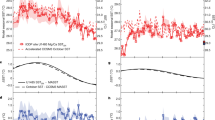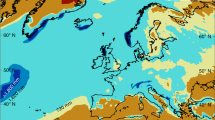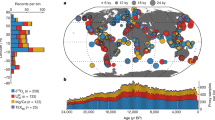Abstract
The extent of climate variability during the current interglacial period, the Holocene, is still debated. Temperature records derived from central Greenland ice cores show one significant temperature anomaly between 8,200 and 8,100 years ago, which is often attributed to a meltwater outflow into the North Atlantic Ocean and a slowdown of North Atlantic Deep Water formation—this anomaly provides an opportunity to study such processes with relevance to present-day freshening of the North Atlantic. Anomalies in climate proxy records from locations around the globe are often correlated with this sharp event in Greenland. But the anomalies in many of these records span 400 to 600 years, start from about 8,600 years ago and form part of a repeating pattern within the Holocene. More sudden climate changes around 8,200 years ago appear superimposed on this longer-term cooling. The compounded nature of the signals implies that far-field climate anomalies around 8,200 years ago cannot be used in a straightforward manner to assess the impact of a slowdown of North Atlantic Deep Water formation, and the geographical extent of the rapid cooling event 8,200 years ago remains to be determined.
This is a preview of subscription content, access via your institution
Access options
Subscribe to this journal
Receive 51 print issues and online access
$199.00 per year
only $3.90 per issue
Buy this article
- Purchase on Springer Link
- Instant access to full article PDF
Prices may be subject to local taxes which are calculated during checkout

Similar content being viewed by others
References
De Vernal, A., Hillaire-Marcel, C., Von Grafenstein, U. & Barber, D. Researchers look for links among paleoclimate events. Eos 78, 247–249 (1997)
Alley, R. B. et al. Holocene climatic instability: A large event 8000–8400 years ago. Geology 25, 482–486 (1997)
Barber, D. C. et al. Forcing of the cold event of 8,200 years ago by catastrophic drainage of Laurentide lakes. Nature 400, 344–348 (1999)
Curry, R., Dickson, B. & Yashayaev, I. A change in the freshwater balance of the Atlantic Ocean over the past four decades. Nature 426, 826–829 (2003)
Weaver, A. J. & Hillaire-Marcel, C. Global warming and the next ice age. Science 304, 400–402 (2004)
Kuijpers, A. et al. Late Quaternary sedimentary processes and ocean circulation changes at the Southeast Greenland margin. Mar. Geol. 195, 109–129 (2003)
Renssen, H., Goosse, H. & Fichefet, T. Modelling the effect of freshwater pulses on the early Holocene climate: the influence of high-frequency climate variability. Paleoceanography 17, doi:10.1029/2001PA000649 (2002)
Bauer, E., Ganopolski, A. & Montoya, M. Simulation of the cold climate event 8200 years ago by meltwater outburst from Lake Agassiz. Paleoceanography 19, doi:10.1029/2004PA001030 (2004)
O'Brien, S. R. et al. Complexity of Holocene climate as reconstructed from a Greenland ice core. Science 270, 1962–1964 (1995)
DeMenocal, P., Ortiz, J., Guilderson, T. & Sarnthein, M. Abrupt onset and termination of the African humid period: rapid climate responses to gradual insolation forcing. Quat. Sci. Rev. 19, 347–361 (2000)
Mayewski, P. A. et al. Holocene climate variability. Quat. Res. 62, 243–255 (2004)
Mayewski, P. A. et al. Major features and forcing of high latitude northern hemisphere atmospheric circulation using a 110,000-year-long glaciochemical series. J. Geophys. Res. 102, 26345–26366 (1997)
Taylor, K. C. et al. Ice core dating and chemistry by direct current electrical conductivity. J. Glaciol. 38, 325–332 (1992)
Taylor, K. C. et al. The ‘flickering switch’ of late Pleistocene climate change. Nature 361, 432–436 (1993)
Risebrobakken, B., Jansen, E., Andersson, C., Mjelde, E. & Hevrøy, K. A high-resolution study of Holocene paleoclimatic and paleoceanographic changes in the Nordic Seas. Paleoceanography 18, doi:10.1029/2002PA000764 (2003)
McDermott, F., Mattey, D. O. & Hawkesworth, C. Centennial-scale Holocene climate variability revealed by a high-resolution speleothem δ18O record from SW Ireland. Science 294, 1328–1331 (2001)
Baldini, J. U., McDermott, F. & Fairchild, I. J. Structure of the 8200-year cold event revealed by a speleothem trace element record. Science 296, 2203–2206 (2002)
Von Grafenstein, U., Erlenkeuser, H., Brauer, A., Jouzel, J. & Johnsen, S. J. A mid-European decadal isotope-climate record from 15,500 to 5000 years B.P. Science 284, 1654–1657 (1999)
Spurk, M., Leuschner, H. H., Baillie, M. G. L., Briffa, K. R. & Friedrich, M. Depositional frequency of German subfossil oaks: climatically and non-climatically induced fluctuations in the Holocene. Holocene 12, 707–715 (2002)
Veski, S., Seppä, H. & Ojala, A. E. K. Cold event at 8200 yr B.P. recorded in annually laminated lake sediments in eastern Europe. Geology 32, 681–684 (2004)
Nesje, A., Matthews, J. A., Dahl, S. O., Berrisford, M. S. & Andersson, C. Holocene glacier fluctuations of Flatbreen and winter-precipitation changes in the Jostedalsbreen region, western Norway, based on glaciolacustrine sediment records. Holocene 11, 267–280 (2001)
Nesje, A., Dahl, S. O. & Bakke, J. Were abrupt Late glacial and early-Holocene climatic changes in northwest Europe linked to freshwater outbursts to the North Atlantic and Arctic Oceans? Holocene 14, 299–310 (2004)
Bond, G. et al. Persistent solar influence on north Atlantic climate during the Holocene. Science 294, 2130–2136 (2001)
Bond, G. et al. A pervasive millennial-scale cycle in North Atlantic Holocene and Glacial climates. Science 278, 1257–1266 (1997)
Moros, M. et al. Sea surface temperatures and ice rafting in the Holocene North Atlantic: climate influences on northern Europe and Greenland. Quat. Sci. Rev. 23, 2113–2126 (2004)
Haug, G. H., Hughen, K. A., Peterson, L. C., Sigman, D. M. & Röhl, U. Southward migration of the Intertropical Convergence Zone through the Holocene. Science 293, 1304–1308 (2001)
Hughen, K. A., Overpeck, J. T., Peterson, L. C. & Trumbore, S. Rapid climate changes in the tropical Atlantic region during the last deglaciation. Nature 380, 51–54 (1996)
Gasse, F. Hydrological changes in the African tropics since the last glacial maximum. Quat. Sci. Rev. 19, 189–211 (2000)
Rohling, E. J. et al. African monsoon variability during the previous interglacial maximum. Earth Planet. Sci. Lett. 202, 61–75 (2002)
Rohling, E. J. et al. Reconstructing past planktic foraminiferal habitats using stable isotope data: a case history for Mediterranean sapropel S5. Mar. Micropaleontol. 50, 89–123 (2004)
Fleitmann, D. et al. Holocene forcing of the Indian monsoon recorded in a stalagmite from Southern Oman. Science 300, 1737–1739 (2003)
Neff, U. et al. Strong coherence between solar variability and the monsoon in Oman between 9 and 6 kyr ago. Nature 411, 290–293 (2001)
Staubwasser, M., Sirocko, F., Grootes, P. M. & Erlenkeuser, H. South Asian monsoon climate change and radiocarbon in the Arabian Sea during early and middle Holocene. Paleoceanography 17, doi:10.1029/2000PA000608 (2002)
Jung, S. J. A., Davies, G. R., Ganssen, G. & Kroon, D. Decadal-centennial scale monsoon variations in the Arabian Sea during the early Holocene. Geochem. Geophys. Geosyst. 3, doi:10.1029/ 2002GC000348 (2002)
Hong, Y. T. et al. Correlation between Indian Ocean summer monsoon and North Atlantic climate during the Holocene. Earth Planet. Sci. Lett. 211, 371–380 (2003)
Yuan, D. et al. Timing, duration, and transitions of the Last Interglacial Asian monsoon. Science 304, 575–578 (2004)
Rohling, E. J., Mayewski, P. A., Hayes, A., Abu-Zied, R. H. & Casford, J. S. L. Holocene atmosphere-ocean interactions: records from Greenland and the Aegean Sea. Clim. Dyn. 18, 587–593 (2002)
Denton, G. H. & Karlen, W. Holocene climatic variations—Their pattern and possible cause. Quat. Res. 3, 155–205 (1973)
Van Geel, B. et al. The role of solar forcing upon climate change. Quat. Sci. Rev. 18, 331–338 (1999)
St-Onge, G., Stoner, J. S. & Hillaire-Marcel, C. Holocene paleomagnetic records from the St. Lawrence estuary, eastern Canada: centennial- to millennial-scale geomagnetic modulation of cosmogenic isotopes. Earth Planet. Sci. Lett. 209, 113–130 (2003)
Muscheler, R., Beer, J. & Vonmoos, M. Causes and timing of the 8200 yr BP event inferred from the comparison of the GRIP 10Be and the tree ring Δ14C record. Quat. Sci. Rev. 23, 2101–2111 (2004)
Muscheler, R., Beer, J., Kubik, P. W. & Synal, H. A. Geomagnetic field intensity during the last 60,000 years based on 10Be and 36Cl from the Summit ice cores and 14C. Quat. Sci. Rev. (in the press)
Haigh, J. D. The impact of solar variability on climate. Science 272, 981–984 (1996)
Shindell, D., Rind, D., Balachandran, N., Lean, J. & Lonergan, P. Solar cycle variability, ozone, and climate. Science 284, 305–308 (1999)
Grootes, P. M., Stuiver, M., White, J. W. C., Johnsen, S. J. & Jouzel, J. Comparison of oxygen isotope records from the GISP2 and GRIP Greenland ice cores. Nature 366, 552–554 (1993)
Cuffey, K. M. & Clow, G. D. Temperature, accumulation, and ice sheet elevation in central Greenland through the last deglacial transition. J. Geophys. Res. 102, 26383–26396 (1997)
NGRIP members. High-resolution record of Northern Hemisphere climate extending into the last interglacial period. Nature 431, 147–151 (2004)
Johnsen, S. et al. Irregular glacial interstadials recorded in a new Greenland ice core. Nature 359, 311–313 (1992)
Cacho, I., Grimalt, J. O. & Canals, M. Response of the Western Mediterranean Sea to rapid climatic variability during the last 50,000 years: a molecular biomarker approach. J. Mar. Syst. 33–34, 253–272 (2002)
Sprovieri, R., Di Stefano, E., Incarbona, A. & Gargano, M. E. A high-resolution record of the last deglaciation in the Sicily Channel based on foraminifera and calcareous nannofossil quantitative distribution. Palaeogeogr. Palaeoclimatol. Palaeoecol. 202, 119–142 (2003)
Acknowledgements
We thank all colleagues who generously made their data available, either directly or through the NOAA National Geophysical Data Centre, and J. Thomson for discussions and suggestions.
Author information
Authors and Affiliations
Corresponding author
Ethics declarations
Competing interests
The authors declare that they have no competing financial interests.
Supplementary information
Supplementary Notes
The file contains a description of the statistical technique used for identifying anomalies in the data presented in the main text. It also contains the results of the statistical analyses as Supplementary Table S1 and Supplementary Figure S1. Supplementary Table S2 lists the characteristics of the data series portrayed in the main text, including reported dating uncertainties, references, and the intervals marking the anomalies highlighted with coloured boxes in Figure 1 of the main text. (PDF 2160 kb)
Rights and permissions
About this article
Cite this article
Rohling, E., Pälike, H. Centennial-scale climate cooling with a sudden cold event around 8,200 years ago. Nature 434, 975–979 (2005). https://doi.org/10.1038/nature03421
Issue Date:
DOI: https://doi.org/10.1038/nature03421
This article is cited by
-
Hydroclimate variability in the central Mediterranean during MIS 17 interglacial (Middle Pleistocene) highlights timing offset with monsoon activity
Scientific Reports (2023)
-
Transient vegetation degradation reinforced rapid climate change (RCC) events during the Holocene
npj Climate and Atmospheric Science (2023)
-
Neolithic hydroclimatic change and water resources exploitation in the Fertile Crescent
Scientific Reports (2023)
-
Human forager response to abrupt climate change at 8.2 ka on the Atlantic coast of Europe
Scientific Reports (2022)
-
Deglacial increase of seasonal temperature variability in the tropical ocean
Nature (2022)
Comments
By submitting a comment you agree to abide by our Terms and Community Guidelines. If you find something abusive or that does not comply with our terms or guidelines please flag it as inappropriate.



